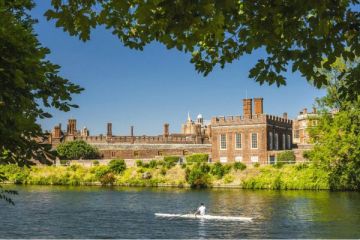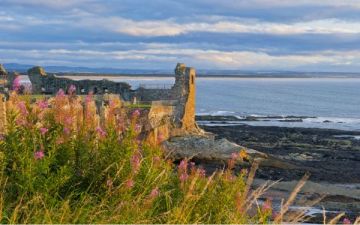Part 3 of 4
The Prince Philip who returned to Britain at the start of 1946 was a markedly different young man to the one who had left her shores six years earlier to serve in the Royal Navy. In place of the bold if inexperienced young officer, there now stood an acknowledged war hero, a First Lieutenant whose bravery and maturity had been recognised in despatches and who had been present in Tokyo Bay to witness Japan’s historic signing of the surrender that ended the second world war. Furthermore, the Prince returned with the understanding that he had also captured the heart of Princess Elizabeth. Yet the courtship faced immediate hurdles, in the form of establishment expectations and social snobbery.
A charming anecdote of the time illustrates the extent to which Philip’s fondness for the Princess was reciprocated. Courtiers recollect that, upon the Prince’s return from active service in the Far East, Elizabeth took to listening to one record above all others on her treasured gramophone. That record was part of the score for the Rogers and Hammerstein musical, Oklahoma! – a song entitled 'People Will Say We’re in Love'. There was little doubt within the Royal circle that the Princess’s musical choice reflected the couple’s mutual feelings.
But before any possible union could be considered, there were two pressing issues to be addressed. The first concerned Philip’s nationality. Although he had been born Prince of Greece and Denmark, he was effectively a prince with neither home nor throne. Even though a Greek plebiscite of September 1946 had served to restore its beleaguered Monarchy, Palace advisers acknowledged that Philip’s best chance of marriage to Elizabeth lay in becoming a naturalised Briton.
The case for his naturalisation was further supported by the fact that the Navy was unwilling to extend him a peace-time commission unless he became a British subject. With the intervention and ceaseless labours of his uncle, Lord Mountbatten, this first problem was quickly overcome, and, on March 18, 1947, Philip Schleswig-Holstein-Sonderburg-Glucksberg, renounced his Greek Royal titles and became Lieutenant Philip Mountbatten, a naturalised Briton.
The second problem, alas, was not quite so easily remedied. At the time, certain Members of Parliament and, indeed, of the Royal Family itself, felt that the match had come too soon and expressed reservations about both the Princess’s youth and her choice of suitor. The King and Queen believed that their daughter – still a teenager – was too young and inexperienced to marry the naval officer who had so obviously won her heart. Others, meanwhile, opined that Philip’s very nature should preclude him from becoming the Crown consort.
His detractors pointed out that Philip’s propensity for speaking his mind, and his refusal to follow convention when it came into conflict with his principles, might prove a liability in this high-profile and sensitive role. There were mutterings that Philip’s phlegmatic and characteristically uncompromising attitude to life appeared to have been strengthened by his experience of war.
Some members of the Royal Family and senior politicians privately suggested that Philip should not be regarded as a true “English gentleman”, and so should be denied access to the highest echelons of the Family, simply because he had attended school at Gordonstoun rather than Eton. In the Prince’s defence, other courtiers argued that the British Royal Family had always proved an adaptive and diverse institution, and that “new blood” had rarely tarnished its reputation.
Fortunately for the young couple, those who opposed their marriage seemed to have left rather an important factor out of their equation – the British public. For not only had the people had taken to the beautiful, fun-loving and relentlessly cheerful Princess Elizabeth, but they were also determinedly keen on the handsome Philip Mountbatten who had, after all, fought for them and their freedom in the Pacific theatre of war. This adulation was further compounded by a more widespread desire to see the austerity of the immediate post-war years brightened by the prospect of a Royal wedding.
The public soon had its way. On July 8, 1947, Buckingham Palace announced the engagement of Princess Elizabeth and Lieutenant Philip Mountbatten. In keeping with his imminent entry into the Family and the status it involved, Philip was created Duke of Edinburgh, Earl of Merioneth, Baron Greenwich, with the style of His Royal Highness, and was appointed a Knight of the Garter.
The wedding, which followed on November 20 of the same year at Westminster Abbey, did not disappoint. As one witness succinctly put it, in its mix of old and new, tradition and innovation, it took on so modern and international a dimension that it resembled nothing so much as “a movie premiere, an election, a World Service and Guy Fawkes Night all rolled into one”. It was, in many ways, indicative of the more progressive and contemporary direction the British Monarchy was soon to take under the stewardship of Elizabeth.
From the outset of his marriage, Philip was intent on proving that his commitment to a more modern and “in touch” Monarchy was every inch the equal to that of his new bride. To this end, he steadfastly continued his rise up the ladder of naval command, demonstrating both his passion for the active life and his determination to combine a career as well as a title. After spells spent instructing at the Petty Officers’ School and attending the Naval Staff College in Greenwich, the Duke was keen to return to what he loved best – sailing.
Although Philip was delighted to return to his vocation, his joy was inevitably mitigated by the knowledge that as a new husband, his duty to his wife would have to co-exist with and perhaps even eclipse his duty to the Navy. “In 1947, I thought I was going to have a career in the Navy, but it became obvious there was no hope,” he later recalled. He knew he was needed: “The Royal Family then was just the King and the Queen and the two Princesses.”
Following the birth of Charles in November 1948, that duty became more apparent still. The Duke succeeded in striking a balance between the two, juggling his role as a new father with his tasks as First Lieutenant aboard HMS Chequers, which was then Leader of the First Destroyer Flotilla in the Mediterranean Fleet. In 1950, he received promotion and found himself a Lieutenant Commander and, soon afterwards, in command of the frigate HMS Magpie.
Later, the Duke was to recall: “The first 10 years [of marriage] I don’t remember much about.” Frequently, he said, “I did my own thing. Got involved in organisations where I thought I could be useful. The Federation of London Boys’ Clubs, the Royal Yachting Association, the MCC...”
This is Part 3 of a 4 part profile
Part 1
Part 2
Part 4

Contents copyright 1999-2001 The Royal Report
NOTE: The Royal Report is sadly no longer online.


